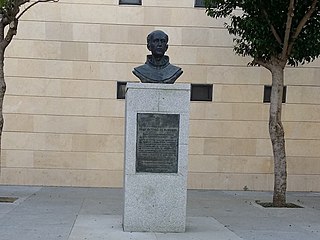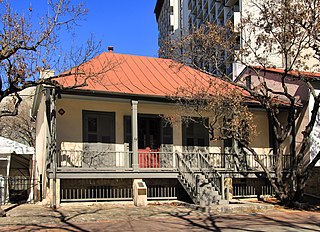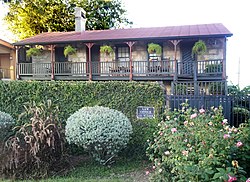
Bexar County is a county in the U.S. state of Texas. As of the 2010 census, the population was 1,714,773, and a 2019 estimate put the population at 2,003,554. It is the 16th-most populous county in the nation and the fourth-most populated in Texas. Its county seat is San Antonio, the second-most populous city in Texas and the seventh-largest city in the United States.

The Alamo Mission, commonly called the Alamo and originally known as the Misión San Antonio de Valero, is a historic Spanish mission and fortress compound founded in the 18th century by Roman Catholic missionaries in what is now San Antonio, Texas, United States. It was the site of the Battle of the Alamo in 1836. Today it is a museum in the Alamo Plaza Historic District and a part of the San Antonio Missions World Heritage Site.

The Espada Acequia, or Piedras Creek Aqueduct, was built by Franciscan friars in 1731 in what is now San Antonio, Texas, United States. It was built to supply irrigation water to the lands near Mission San Francisco de la Espada, today part of San Antonio Missions National Historical Park. The acequia is still in use today and is an Historic Civil Engineering Landmark and a National Historic Landmark.

Von Ormy is a city in southwest Bexar County, Texas, United States. As of the 2010 census, it had a population of 1,086. It is part of the San Antonio metropolitan statistical area.

La Villita Historic Arts Village is an art community in downtown San Antonio, Texas, United States. There are art galleries, stores selling souvenirs, gifts, custom jewelry, pottery, and imported Mexican folk art, as well as several restaurants in the district. La Villita connects to the San Antonio River Walk and its outdoor venue, the Arneson River Theatre. It is close to the Alamo, the Henry B. Gonzalez Convention Center, Rivercenter Mall, and HemisFair Park. It is within walking distance of most downtown hotels.

Franciscan Friars established Mission Nuestra Señora de la Purísima Concepción de Acuña in 1711 as Nuestra Señora de la Purísima Concepción de los Hainais in East Texas. The mission was established by the Domingo Ramón-St. Denis expedition and was originally meant to be a base for converting the Hasinai to Catholicism and teaching them what they needed to know to become Spanish citizens. The friars moved the mission in 1731 to San Antonio. After its relocation most of the people in the mission were Pajalats who spoke a Coahuiltecan language. Catholic Mass is still held every Sunday.
The City of San Antonio is one of the oldest Spanish settlements in Texas and was, for decades, its largest city. Before Spanish colonization, the site was occupied for thousands of years by varying cultures of indigenous peoples. The historic Payaya Indians were likely those who encountered the first Europeans.

Antonio de San Buenaventura y Olivares or simply Fray Antonio de Olivares was a Spanish Franciscan who officiated at the first Catholic Mass celebrated in Texas, and he was known for contributing to the founding of San Antonio and to the prior exploration of the area. He founded, among other missions, the Alamo Mission in San Antonio, the Presidio San Antonio de Bexar, and the Acequia Madre de Valero.

Presidio de Béxar was a Spanish fort built near the San Antonio River, located in what is now San Antonio, Texas, in the United States. It was designed for protection of the mission San Antonio de Valero and the Villa de Bejar. The Presidio de Bejar was founded on May 5, 1718 by Spanish Governor Martin de Alarcon and his 35 Presidio Soldiers. The Villa de Bejar is known for being the first Spanish settlement of San Antonio and consisted of the families of the Presidio Soldiers and those of the prior expeditions. It also served to secure Spain's claim to the region from French, English and American aggression.

The Alamo Cenotaph, also known as The Spirit of Sacrifice, is a monument in San Antonio, Texas, United States, commemorating the Battle of the Alamo of the Texas Revolution, which was fought at the adjacent Alamo Mission. The monument was erected in celebration of the centenary of the battle, and bears the names of those known to have fought there on the Texas side.

The Conservation Society of San Antonio is located in the Bexar County city of San Antonio in the U.S. state of Texas. Founding members were Emily Edwards, who became the organization's first president, and Rena Maverick Green. The organization was formed on March 22, 1924, and officially incorporated on July 8, 1925. The Society is currently headquartered in the Anton Wulff House, which they saved from destruction in 1974. The home was built 1869–1870 by German immigrant Anton Wulff, who became the city's first Park Commissioner.

The Edward Steves Homestead is located in the Bexar County city of San Antonio in the U.S. state of Texas. It was designed by architect Alfred Giles and designated a Recorded Texas Historic Landmark. The main house was donated to the San Antonio Conservation Society in 1952. The organization completely restored the main house as a museum and now conducts daily tours. The complete homestead property consists of four individual structures: the main house museum, the carriage house, the river house, and the servants' quarters. It is listed on the National Register of Historic Places listings in Bexar County, Texas, as a contributing structure of the King William Historic District.

Acequia Park is located in the Bexar County city of San Antonio in the U.S. state of Texas. There are picnic tables and restrooms, but alcohol is not allowed in the park. The origins of the park date back to Spanish missionaries, who worked with mission Indians to create a water system sourced by the San Antonio River. The San Antonio Conservation Society (SACS) purchased much of this acreage in 1957 to preserve the area's environment. Because the San Antonio River Authority planned to reconfigure the river channel, SACS joined local land owners in filing a successful water rights and water flow lawsuit against the Authority. In 1975, SACS deeded the property to the City of San Antonio with the stipulation that it be used as a public park.

The Jeremiah Dashiell House is located in the Bexar County city of San Antonio in the U.S. state of Texas. Also known as Casa Villita, it was designated a Recorded Texas Historic Landmark under that name in 1962. It is listed on the National Register of Historic Places listings in Bexar County, Texas as a contributing structure of the La Villita Historic District.

The Anton Wulff House is located in the Bexar County city of San Antonio in the U.S. state of Texas. It was designated a Recorded Texas Historic Landmark in 1976. It is listed on the National Register of Historic Places listings in Bexar County, Texas as a contributing structure of the King William Historic District. The house has been the headquarters of the San Antonio Conservation Society since 1975. German immigrant businessman Wulff was a city alderman, San Antonio's first park commissioner, and the man who designed the layout and beautification of Alamo Plaza.

The Yturri–Edmunds Historic Site is a historic site in San Antonio, Texas. The house is listed on the National Register of Historic Places listings in Bexar County, Texas. The homestead and mill were designated a Recorded Texas Historic Landmark in 1966.

Yanaguana was the Payaya people village in the geographical area that became the Bexar County city of San Antonio, in the U.S. state of Texas. Some accounts believe the Payaya also referred to the San Antonio River as Yanaguana, and it is sometimes promoted as such for the tourist industry. For a number of years, the city of San Antonio contracted with Yanaguana Cruises Inc. for an exclusive monopoly to operate tour barges on a select section of the river. The National Park Service has a designated "Yanaguana Trail" that runs along the river at Mission San Juan Capistrano. In 1933 Frederick C. Chabot of San Antonio formed the Yanaguana Society, specifically named for the Payaya village, to collect and preserve the early artifacts and history of the area. The organization lasted through 1960.

The Staacke Brothers Building is located in the Bexar County city of San Antonio in the U.S. state of Texas. It is listed on the National Register of Historic Places listings in Bexar County, Texas. The structure was designated a Recorded Texas Historic Landmark in 1984.

Acequia Madre de Valero is an 18th-century agricultural irrigation canal built by the Spanish and located in the Bexar County city of San Antonio in the U.S. state of Texas. When Martín de Alarcón founded San Antonio for Spain by establishing San Antonio de Valero Mission in 1718, Franciscan priest Antonio de Olivares and the Payaya people dug Acequia Madre de Valero by hand. It was vital to the missions to be able to divert and control water from the San Antonio River, in order to grow crops and to supply water to the people in the area. This particular acequia was the beginning of a much wider acequia system. Acequia Madre de Valero ran from the area currently known as Brackenridge Park and southward to what is now Hemisfair Plaza and South Alamo Street. Part of it that is not viewable by the public runs beneath the Menger Hotel. The acequia was restored in 1968 and that year was designated a Recorded Texas Historic Landmark.

The St. Joseph Catholic Church is a Roman Catholic parish church in the Roman Catholic Archdiocese of San Antonio, located at 623 East Commerce Street in downtown San Antonio, Texas, United States. The Gothic Revival house of worship was the fourth Catholic parish in the city.



















